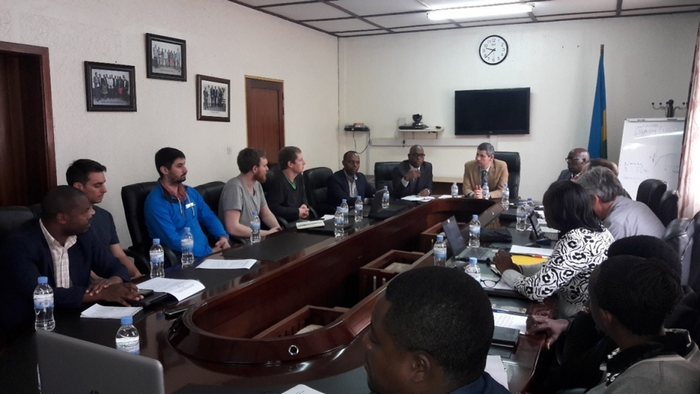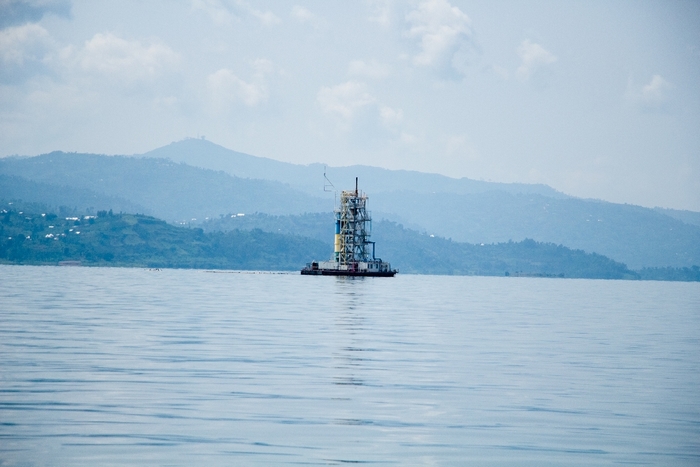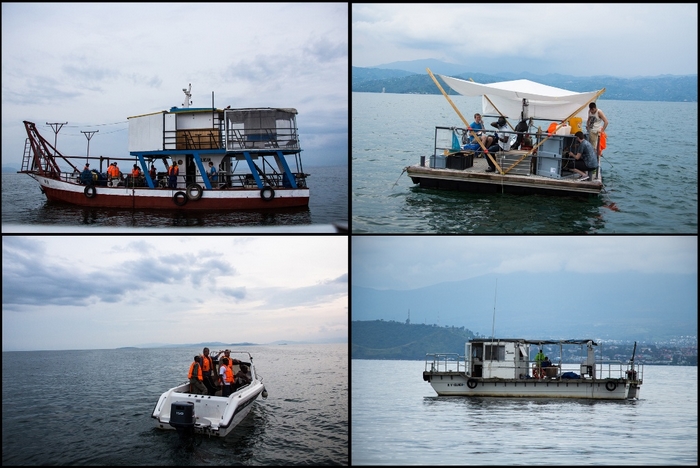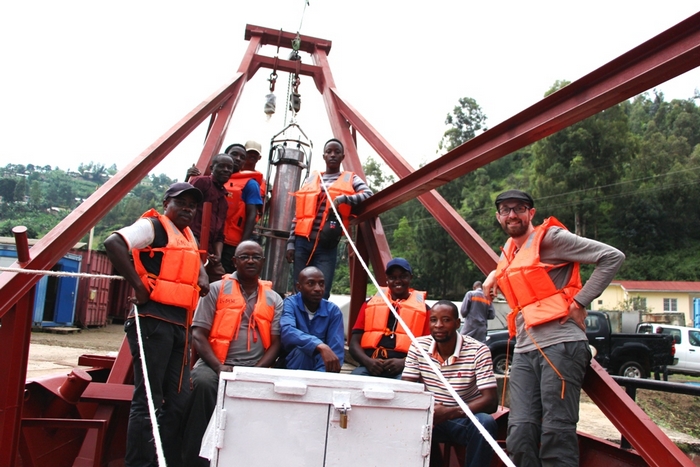SUBOCEAN : The first attempt for continuous methane profile of the meromictic Lake Kivu in Rwanda
Limnology is not a main field of interest at IGE. However, during the development of the SUBGLACIOR probe [1,2] part of the team realised the potential for a new fast response extraction system (now the object of a patent [3]) that could be used to continuously measure dissolved gases in water, being in the ocean or in lakes.
Following first proofing in 2014 the capability of the probe for continuous profiling in the Mediterranean sea [4] and following its first deployment over a methane hydrate degassing area on the west coast of Svalbard in the Arctic in 2015 [5], the team decided to challenge its concept in additional challenging environment : measuring dissolved methane in Lake Kivu in Rwanda. The challenge is related to the extremely high concentration of CH4 in the anoxic layers of this unique lake, 6 orders of magnitude higher than what SUBOCEAN is normally capable of measuring. Before the campaign, the dynamic range of the sensor has thus been readapted for accessing the high concentration conditions of the dissolved gas.
Lake Kivu is a meromictic lake of volcanic origin. Half of the lake belongs to Rwanda, while the other half is property of to the Democratic Republic of Congo. Located at 1460 m above sea level, Lake Kivu has a surface of 2 700 km2 and a maximum depth of 470 m. The stratification of the lake is quite particular, with an aerobic environment in the shallow part and fully anoxic, dense and salty waters at the bottom, with high concentration of CH4, CO2 and H2S. Because of the strong density gradient, bottom water never mixes with shallow one. Natural events such as volcanic eruptions or earthquakes could in principle trigger a catastrophic water overturning. This already happened in the past on similar type of lakes such as at Lake Nyos in Cameroun in 1986, where an overturning took place bringing CO2-enriched bottom waters at the surface, and killing more than 1700 people through asphyxia. The population around Lake Kivu totals one million inhabitants…
Lake Kivu contains 300 km3 of CO2 and 60 km3 of CH4 at standard temperature and pressure. Already ten years ago, the government of Rwanda started to invest on the extraction of deep dissolved methane from the lake for energy production. Today, the lake shore power plant operated by KivuWatt produces up to 26 MW of energy, which corresponds to about 10 % of the total amount produced by the country. The objective of the government is to increase the energy production from the lake, and to use the extracted methane not only for producing energy but also for distributing natural gas to villages.
However, important questions require an answer before possibly increasing the methane extraction, and in particular : What is the actual budget of CH4 in the lake ? What is its evolution ? Is the lake stable ? What kind of monitoring procedures should be put in place in order to prevent any possible disaster ? For this, the Energy Development Corporation Limited (EDCL) nominated an expert’s advisory group (including Jérôme Chappellaz and Roberto Grilli from IGE) for establishing a monitoring program of the lake.
A first inter-comparison campaign of different measurement techniques organized by Augusta Umutoni and Ange Mugisha from EDCL took place from 6th to 14th of March 2018. Measurement of dissolved gases were performed by the group of Martin Schmid from EAWAG (Switzerland), Bertram Boehrer and Wolf von Tümpling from UFZ (Switzerland), François Darchambeau from KivuWatt (Rwanda) and Roberto Grilli from IGE who brought and operate the SUBOCEAN probe on site. The different techniques used during the campaign included water sampling at different depths followed by GC analysis in the laboratory, in situ mass spectrometry measurement of pumped water at different depths, discrete measurements with a commercial Contros instrument, and lastly continuous profiling throughout the water column with the SUBOCEAN probe. This inter-comparison will allow a more accurate quantification of the gas dissolved in the lake, paving the basis for setting up a long term monitoring strategy of the lake.
The SUBOCEAN probe successfully registered at several spots through the lake continuous profiles on the shallow part of the lake, down to 150 m of depth. The attempt to accurately measure dissolved methane at large depths unfortunately did not succeed because of the extremely high concentrations of methane in the deepest anoxic sections of the lake. Nevertheless, the registered profiles will allow to succeed with the inter-comparison, and will provide for the first time high resolution details never observed before, which will be much useful to understand the stratification of the lake in different layers. The data analysis in still under process, and the experts will have a meeting in May for discussing the results and planning future actions.
In the end, it is well possible that a long-term collaboration be officialised, with possibly the association of a private partner through which the SUBOCEAN patent is valorised.
Contacts :
Roberto Grilli : roberto.grilli cnrs.fr
Jérôme Chappellaz : Jerome.Chappellaz univ-grenoble-alpes.fr
- (1) Grilli, R. ; Marrocco, N. ; Desbois, T. ; Guillerm, C. ; Triest, J. ; Kerstel, E. ; Romanini, D. Invited Article : SUBGLACIOR : An optical analyzer embedded in an Antarctic ice probe for exploring the past climate. Rev. Sci. Instrum. 2014, 85 (111301), 1–8.
- (2) Chappellaz, J. ; Alemany, O. ; Romanini, D. ; Kerstel, E. The IPICS « oldest ice » challenge : a new technology to qualify potential sites. Ice Snow 2012, 4, 57–64.
- (3) Triest, J. ; Chappellaz, J. ; Grilli, R. Patent 08276-01 : System for fast and in-situ sampling of dissolved gases in the ocean (CNRS, Grenoble FRANCE, 2017). 08276–01.
- (4) Grilli, R. ; Triest, J. ; Chappellaz, J. ; Calzas, M. ; Desbois, T. ; Ferré, B. ; Guillerm, C. ; Jansson, P. ; Lechevallier, L. ; Ledoux, V. ; et al. SUBOCEAN : subsea dissolved methane measurements using an embedded laser spectrometer technology. Accept. to Environemental Sci. Technol. 2018.
- (5) Triest J. ; Jansson, P. ; Grilli, R. ; Silyakova, A. ; Mienert, J. ; Chappellaz, J. High resolution sensing of dissolved methane reveals rapid dynamics over a seepage area west of Svalbard (in preparation). 2018.
 La fédération
La fédération Intranet
Intranet














